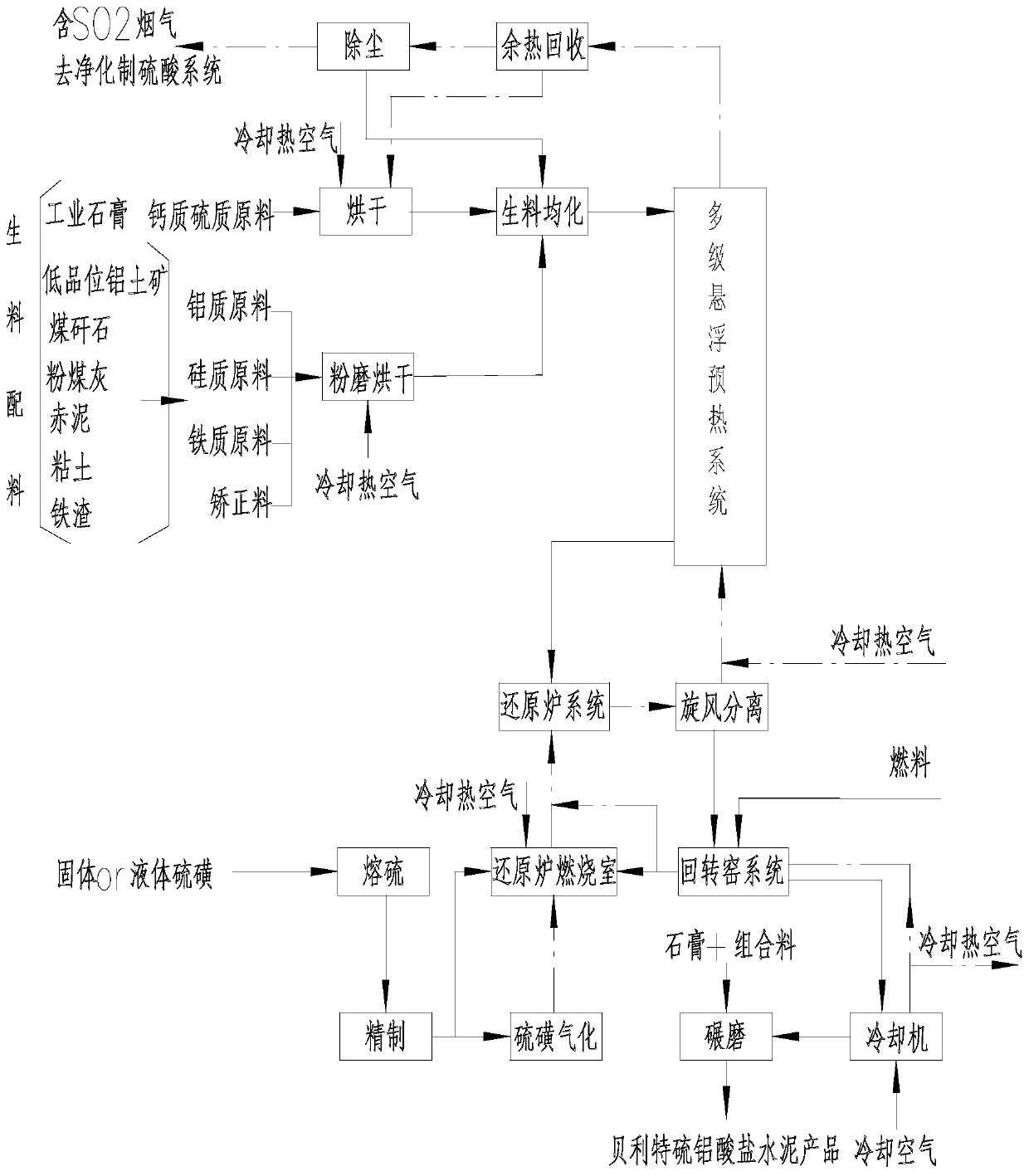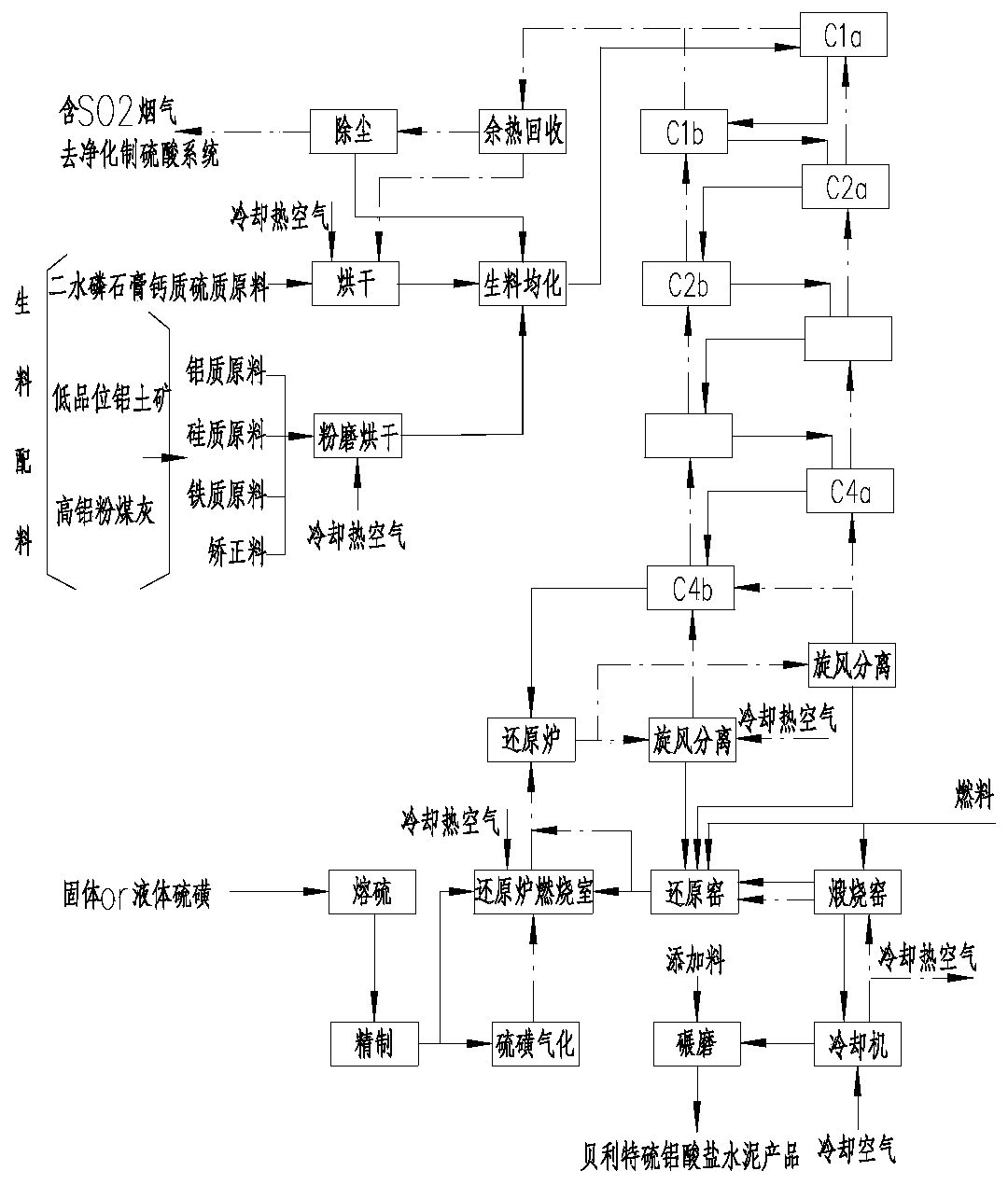Method for preparation of belite sulphoaluminate cement and co-production of sulfuric acid by reducing gypsum with sulfur gas
A Belite sulfoaluminate and teresulfoaluminate technology, which is applied in the field of building materials and chemical products, can solve the problems of high operating costs, difficulties in co-production of sulfuric acid "two conversions and two absorptions", comprehensive utilization rate of less than 40%, etc. question
- Summary
- Abstract
- Description
- Claims
- Application Information
AI Technical Summary
Problems solved by technology
Method used
Image
Examples
preparation example Construction
[0084] F. Preparation of cement
[0085] From the cement clinker from the cooler in step E, add gypsum and composite materials, and then undergo subsequent grinding processing to obtain Belite sulfoaluminate cement products with different performance requirements.
Embodiment 1
[0088] process such as figure 2 As shown, dihydrate phosphogypsum, low-grade bauxite, and high-alumina fly ash are used as raw materials. The raw materials are dried and ground to >95%-80μm, and most of the fly ash produced by the combustion of fuel coal in the rotary kiln enters the In clinker, the chemical composition of raw material and raw meal is shown in Table 1.
[0089] Table 1 Chemical composition of raw materials and raw meal
[0090] project CaO SiO 2
Al 2 o 3
Fe 2 o 3
MgO P 2 o 5
Na 2 o
SO 3
LOSS total Phosphogypsum 32.56 4.76 0.97 0.39 0.31 1.05 0.30 43.63 15.98 99.95 Bauxite 2.25 24,20 53.51 2.45 0.07 0.00 0.13 0.20 17.98 99.73 fly ash 1.48 43.50 35.38 1.92 0.70 0.00 0.33 0.68 14.77 98.76 Raw material 27.34 10.86 8.18 0.69 0.33 0.87 0.29 36.30 15.96 100.00
[0091] The above raw materials of phosphogypsum dihydrate, low-grade bauxite, and ...
Embodiment 2
[0100] process such as image 3 As shown, dihydrate phosphogypsum and high-aluminum fly ash are used as raw materials. The raw materials are dried and ground to >95%-80μm. Most of the fly ash produced by the combustion of fuel coal in the rotary kiln enters the clinker. The raw materials and The chemical composition of the raw meal is shown in Table 4.
[0101] Table 4 Chemical Composition of Raw Materials and Raw Meals
[0102] project CaO SiO 2
al 2 o 3
Fe 2 o 3
MgO P 2 o 5
Na 2 o
SO 3
LOSS total Phosphogypsum 32.56 4.76 0.97 0.39 0.31 1.05 0.30 43.63 15.98 99.95 fly ash 1.48 43.50 35.38 1.92 0.70 0.00 0.33 0.68 14.77 99.73 Raw material 27.72 10.91 6.42 0.63 0.37 0.89 0.31 36.93 15.83 100.00
[0103] The above-mentioned phosphogypsum dihydrate and high-alumina fly ash raw materials are composed by weight: 84.2 parts of phosphogypsum dihydrate and 15.8 parts of high-a...
PUM
 Login to View More
Login to View More Abstract
Description
Claims
Application Information
 Login to View More
Login to View More - R&D
- Intellectual Property
- Life Sciences
- Materials
- Tech Scout
- Unparalleled Data Quality
- Higher Quality Content
- 60% Fewer Hallucinations
Browse by: Latest US Patents, China's latest patents, Technical Efficacy Thesaurus, Application Domain, Technology Topic, Popular Technical Reports.
© 2025 PatSnap. All rights reserved.Legal|Privacy policy|Modern Slavery Act Transparency Statement|Sitemap|About US| Contact US: help@patsnap.com



